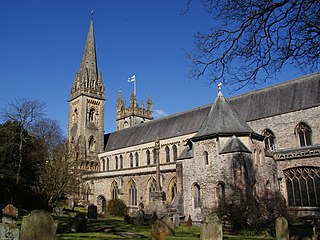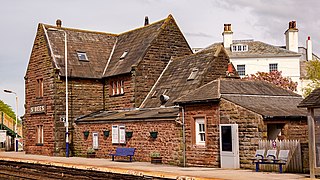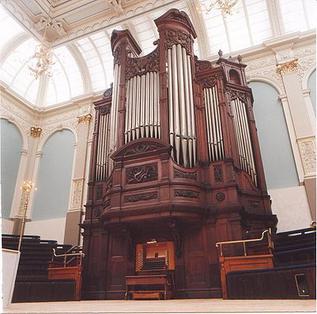Related Research Articles

Llandaff Cathedral is an Anglican cathedral and parish church in Llandaff, Cardiff, Wales. It is the seat of the Bishop of Llandaff, head of the Church in Wales Diocese of Llandaff. It is dedicated to Saint Peter and Saint Paul, and three Welsh saints: Dubricius, Teilo and Oudoceus. It is one of two cathedrals in Cardiff, the other being the Roman Catholic Cardiff Metropolitan Cathedral in the city centre.

Whitehaven is a town and port on the English north west coast and near to the Lake District National Park in Cumberland, Cumbria, England. It lies by road 38 miles (61 km) south-west of Carlisle and 45 miles (72 km) to the north of Barrow-in-Furness. It was the administrative seat of the former Borough of Copeland, and has a town council for the parish of Whitehaven. The population of the town was 23,986 at the 2011 census.

St Bees is a coastal village, civil parish and electoral ward in the Copeland district of Cumbria, England, on the Irish Sea.

St Bees railway station is a railway station serving the village of St Bees in Cumbria, England. It is on the Cumbrian Coast line, which runs between Carlisle and Barrow-in-Furness. It is owned by Network Rail and managed by Northern Trains.

Henry Willis & Sons is a British firm of pipe organ builders founded in 1845. Although most of their installations have been in the UK, examples can be found in other countries.

Henry Willis, also known as "Father" Willis, was an English organ player and builder, who is regarded as the foremost organ builder of the Victorian era. His company Henry Willis & Sons remains in business.

Sir John Lowther, 2nd Baronet FRS was an English politician and landowner. Lowther was born at Whitehaven, in the parish of St Bees, Cumberland, the son of Sir Christopher Lowther, 1st Baronet, and his wife, Frances Lancaster, daughter of Christopher Lancaster of Stockbridge, Westmoreland. He was educated at Ilkley, Yorkshire and Balliol College, Oxford. He served as Member of Parliament for Cumberland from 1665 to 1701, and as a Lord Commissioner of the Admiralty from 1689 to 1696.

St Peter's Church is a Church of England parish church located in the centre of Bournemouth, Dorset, England. It is a Grade I listed building classed as a 'major parish church', and was completed in 1879 to a design by George Edmund Street as the founding mother church of Bournemouth.
Brighton and Hove has numerous notable pipe organs, from the small early 19th-century organs to the large 20th-century instruments in the large churches.

St Hilary's Church is in the town of Wallasey, Wirral, Merseyside, England. It consists of a church built in 1858–59 and the separate tower of a former medieval church. Both the church and the tower are recorded in the National Heritage List for England as designated Grade II listed buildings. The church is an active Anglican parish church in the diocese of Chester, the archdeaconry of Chester and the deanery of Wallasey.

St Bees Lighthouse is a lighthouse located on St Bees Head near the village of St Bees in Cumbria, England. The cliff-top light is the highest in England at 102 m (335 ft) above sea level.

St Bees Priory is the parish church of St Bees, Cumbria, in England. There is evidence for a pre-Norman religious site, and on this a Benedictine priory was founded by the first Norman Lord of Egremont William Meschin, and was dedicated by Archbishop Thurstan of York, sometime between 1120 and 1135.

Holy Name Church in West Roxbury is a Roman Catholic church of the Archdiocese of Boston.
John Dalzell Kenworthy ARCA was an internationally acclaimed artist, sculptor and writer who was born at Whitehaven into a prominent West Cumbrian family.{{Multiple issues|

Immanuel Church is in the village of Feniscowles, near Blackburn, Lancashire, England. It is an active Anglican parish church in the deanery of Blackburn with Darwen, the archdeaconry of Blackburn, and the diocese of Blackburn. The church is recorded in the National Heritage List for England as a designated Grade II listed building.

St Bees Theological College, close to the coast of Cumberland, was the first independent theological college to be established for the training of Church of England ordinands. It was founded in 1816 by George Henry Law, Bishop of Chester, in what was during those years the northern extremity of his diocese. For many subsequent years the vicar of St Bees was effectively both the principal of the college and also its proprietor.

St James' Church is in High Street, Whitehaven, Cumbria, England, at the crossing with the top of Queen Street. It stands in an elevated position overlooking the town. The church is an active Anglican parish church in the deanery of Calder, the archdeaconry of West Cumberland, and the diocese of Carlisle. The church is recorded in the National Heritage List for England as a designated Grade I listed building.

Henry Norris (1816–1878) was a British civil engineer born in Poplar, London, the son of several generations of house carpenters. He was the resident engineer for lighthouse construction projects under contract to Trinity House from civil engineers Messrs. Walker & Burges, the firm of James Walker and Alfred Burges, and later on oversaw the building of Souter Lighthouse, the world's first lighthouse specifically designed & built to be powered by electricity.
Finlay Lorimer Kitchin FGS, FRS was a British geologist and palaeontologist.

Our Lady and St Michael's Church also known as Our Lady Star of the Sea and St Michael's Church is a Roman Catholic Parish church in Workington, Cumbria, England. It was built in 1876 by the Benedictines. It is located on Bank Road and Banklands to the south west of the town centre. It was designed by E. W. Pugin in the Gothic Revival style and is a Grade II listed building.
References
- ↑ "The Father Willis Organ History". Archived from the original on 28 September 2011. Retrieved 21 August 2011.